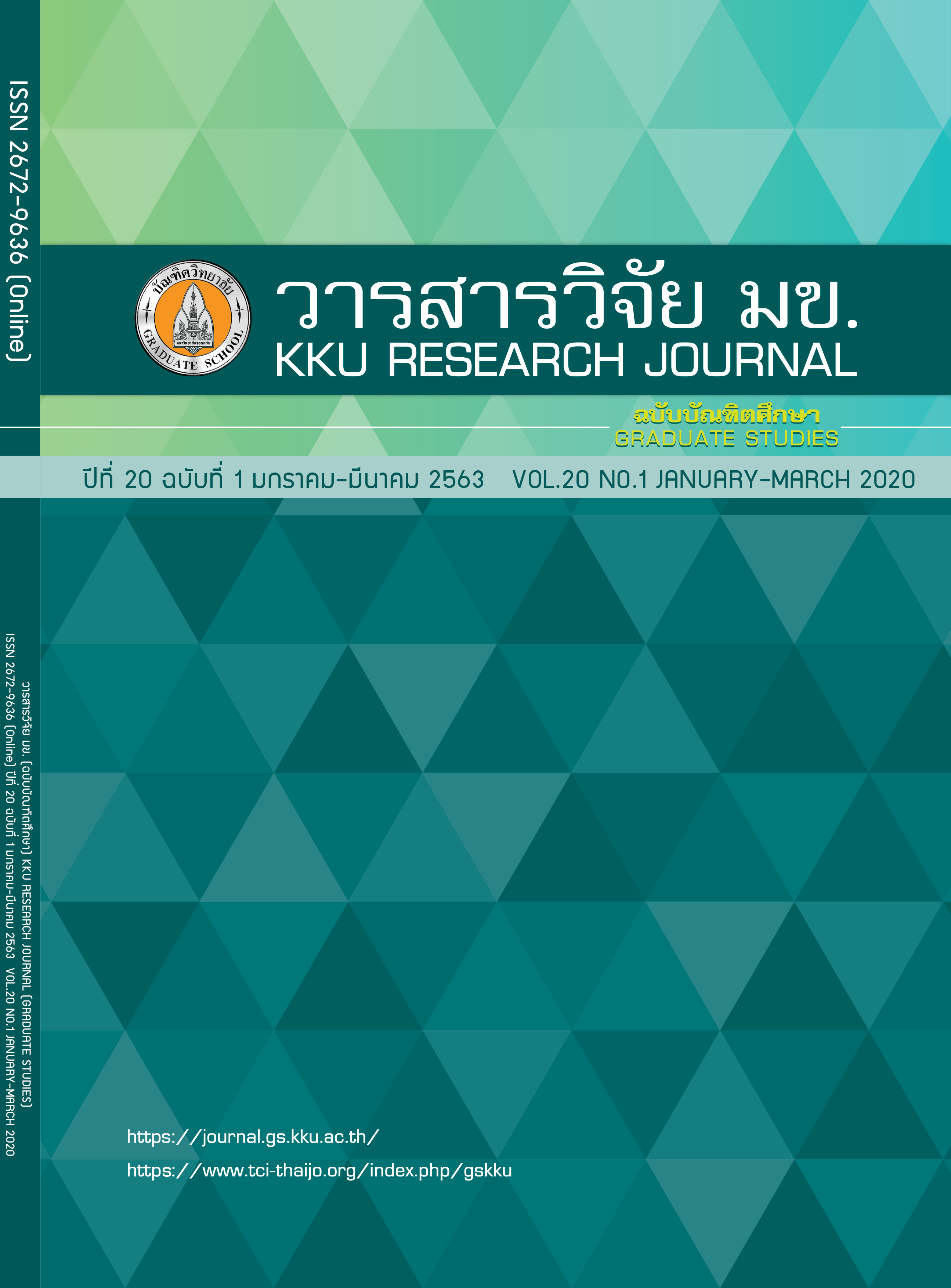การหาสภาวะที่เหมาะสมที่สุดสำหรับการสังเคราะห์เจลแทนนินจากสารสกัดจากเปลือกไม้ยูคาลิปตัส
คำสำคัญ:
เรซิน, เมทิลีนบลู, ตัวดูดซับบทคัดย่อ
จุดมุ่งหมายของงานวิจัยนี้เพื่อหาสภาวะที่เหมาะสมที่สุด สำหรับการสังเคราะห์เจลแทนนินจากสารสกัดจากเปลือกไม้ยูคาลิปตัส โดยใช้การออกแบบการทดลองแบบเซ็นทรัลคอมโพสิตและการวิเคราะห์แบบพื้นผิวตอบสนองเพื่อหาสภาวะที่ดีที่สุด โดยศึกษาผลของปัจจัย 2 ปัจจัย คือ อัตราส่วนโดยมวลของฟอร์มาลดีไฮด์ต่อแทนนินและอุณหภูมิของปฏิกิริยาพอลิเมอร์ไรเซชัน ทดสอบการดูดซับกับสีเมทิลีนบลู (สีย้อมประจุบวก) โดยใช้ความเข้มข้นเริ่มต้น 20 มิลลิกรัมต่อลิตร และปริมาณเจลแทนนินเท่ากับ 20 มิลลิกรัม จากการทดลองพบว่าอิทธิพลหลักของทั้ง 2 ปัจจัย มีผลต่อค่าร้อยละการกำจัดสีเมทิลีนบลูอย่างมีนัยสำคัญ (P-value < 0.05) ในขณะที่อิทธิพลร่วมนั้นไม่มีผลร่วมกัน (P-value > 0.05) ซึ่งสภาวะที่เหมาะสมสำหรับการสังเคราะห์เจลแทนนิน คือที่อัตราส่วนโดยมวลของฟอร์มาลดีไฮด์ต่อแทนนิน เท่ากับ 3.1:1 และอุณหภูมิของปฏิกิริยาพอลิเมอไรเซชันเท่ากับ 80 องศาเซลเซียส และจากการศึกษาไอโซเทอมการดูดซับสีเมทิลีนบลู พบว่าสอดคล้องกับแบบจำลองการดูดซับของแลงเมียร์ ค่าความสามารถในการดูดซับสูงสุดเท่ากับ 135 มิลลิกรัมต่อกรัม งานวิจัยนี้แสดงให้เห็นว่าเจลแทนนินที่สังเคราะห์จากสารสกัดจากเปลือกไม้ยูคาลิปตัสนั้นมีศักยภาพที่จะใช้ในการดูดซับสีย้อมประจุบวกจากสารละลายได้
References
Bacelo HAM, Santos SCR, Botelho CMS. Tannin-based biosorbents for environmental applications – A review. Chemical Engineering Journal. 2016; 303: 575–587.
Maria Rahman M, Akter N, Karim MR, Ahmad N, Rahman MM, Siddiquey IA, et al. Optimization, kinetic and thermodynamic studies for removal of Brilliant Red (X-3B) using Tannin gel. Journal of Environmental Chemical Engineering. 2014; 2(1): 76–83.
Alvares Rodrigues L, Koibuchi Sakane K, Alves Nunes Simonetti E, Patrocínio Thim G. Cr total removal in aqueous solution by PHENOTAN AP based tannin gel (TFC). Journal of Environmental Chemical Engineering. 2015; 3(2): 725–733.
Sánchez-Martín J, Beltrán-Heredia J, Gibello-Pérez P. Adsorbent biopolymers from tannin extracts for water treatment. Chemical Engineering Journal. 2011; 168(3): 1241–1247.
Can M, Bulut E, Örnek A, Özacar M. Synthesis and characterization of valonea tannin resin and its interaction with palladium (II), rhodium (III) chloro complexes. Chemical Engineering Journal. 2013; 221: 146–158.
Yi Q, Fan R, Xie F, Min H, Zhang Q, Luo Z. Selective Recovery of Au(III) and Pd(II) from Waste PCBs Using Ethylenediamine Modified Persimmon Tannin Adsorbent. Procedia EnvironmentalSciences. 2016; 31: 185–194.
Xie F, Fan Z, Zhang Q, Luo Z. Selective adsorption of Au 3+ from aqueous solutions using persimmon powder-formaldehyde resin. Journal AppliedPolymerScience. 2013; 130(6).
Kunnambath PM, Thirumalaisamy S. Characterization and Utilization of Tannin Extract for the Selective Adsorption of Ni ( II ) Ions from Water. Journal of Chemistry. 2015.
Shirato W, Kamei Y, Insoluble tannin preparation process, waste treatment process employing insoluble tannin and adsorption process using tannin, US patent 5,158,711(1992).
Adthalungrong C, Saechua N, Doungkaew K. Lactic Acid Fermentation from Tapioca Starch by Lactobacillus casei TISTR 453 using Simultaneous Saccharification and Fermentation Process. KKU Res. J. 2014; 19(3): 125–133.
Kokkaew H, Srithanyarat N, Pitirit T. Optimization of Anthocyanin and Effects of Acidulants on Phytochemicals and Antioxidant Activities in Purple Waxy Corn Cookies. KKU Res. J. 2015; 20(1): 75–90.
Vieira RC, Santos SCR, Boaventura RAR, Bacelo H, Botelho MS. Recovery and valorization of tannins from a forest waste as an adsorbent for antimony uptake. Journal of Cleaner Production. 2018; 198: 1324–1335.
Zhao M, Jing J, Zhu Y, Yang X, Wang X, Wang Z. Preparation and performance of lignin–phenol–formaldehyde adhesives. Int J Adhes Adhes. International Journal of Adhesion and Adhesives. 2016; 64: 163–167.
Uddin T, Islam A, Mahmud S. Adsorptive removal of methylene blue by tea waste. Journal of Hazardous Materials. 2009; 164: 53–60.
Do M, Abak H, Alkan M. Adsorption of methylene blue onto hazelnut shell : Kinetics , mechanism and activation parameters. Journal of Hazardous Materials. 2009; 164: 172–181.
Ritthichai A, Muncharoen S. Dye Removal of Textile Wastewaters using Crab Shell Activated Carbon. Burapha Sci. J. 2014; 131-140.


